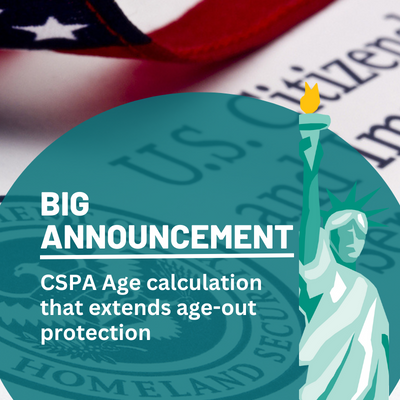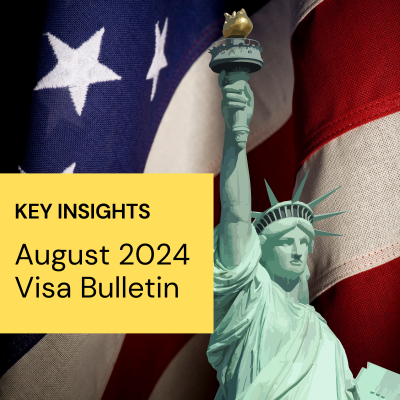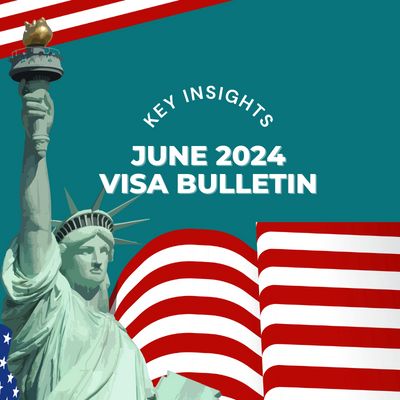For those Children aging out because they have turned 21 before they are able to file their I-485 this is welcome relief. American Immigration Lawyers Association has provided a write up about this relief. As per a recent February 14, 2023 guidance from USCIS on Child Status Protection Act, the age calculation of the child can be frozen even if the child files a I-485 based on the Dates for Filing Chart , earlier the age of the child would be frozen only if the child filed their I-485 based on the Final Action Dates chart of the Visa Bulletin. This allows children who have turned 21 or older to still be able to adjust as minors with their parents and get their green cards at the same time as their parents.
Introduction
As background, the CSPA protects certain noncitizens from losing eligibility as a child for immigrant visa and adjustment of status purposes due to their aging during the immigration process. Until October 2015, CSPA age calculation was tied to a single Visa Bulletin (VB) chart published on a monthly basis by DOS. Specifically, the single VB chart, now known as the Final Action Dates chart, was used to determine both whether an immigrant visa “bec[ame] available” for CSPA age calculation but also whether an adjustment of status application (AOS) could be filed with USCIS. Under the current dual-chart system involving the Final Action Dates and Dates for Filing charts which has been in place since October 2015, USCIS designates one of the two VB charts each month for determining when an AOS may be filed with USCIS.
Under the May 2018 guidance3, USCIS only considered a visa available for CSPA age calculation based on the Final Action Dates chart. Thus, an AOS applicant could have a visa “immediately available” for purposes of filing the application but not have a visa “become available” for purposes of CSPA calculation, meaning that certain AOS applicants who pay for and file based on the Dates for Filing chart do so with no guarantee of CSPA protection.
Updated Guidance from USCIS
On February 14, 2023, USCIS issued revised guidance (February 2023 guidance) on when an immigrant visa number “becomes available” for the purpose of calculating a noncitizen’s age in certain situations under the Child Status Protection Act (CSPA). Under the February 2023 guidance, USCIS will consider a visa available for purposes of CSPA age calculations at the same time USCIS considers a visa available for accepting and processing the AOS application. As an example, when USCIS determines there are more immigrant visas available for a fiscal year than there are known applicants for such visas, and USCIS announces that prospective applicants may use the Dates for Filing chart when filing adjustment of status applications, then USCIS would also use the Dates for Filing chart when calculating the applicant’s CSPA age. Furthermore, when USCIS announces that a prospective applicant must use the Final Action Dates chart when filing the adjustment of status application, then USCIS would use the Final Action Dates chart when calculating the applicant’s CSPA age.
By extension, the one-year period during which a noncitizen must seek to acquire lawful permanent residence for CSPA starts when a visa becomes available for accepting and processing a potential adjustment of status application.4
Furthermore, in the context of transferring the underlying basis of an AOS, the date that the transfer request is received by USCIS is the date used to determine whether the derivative child met the sought to acquire requirement.
Since this guidance is effective immediately and applies to AOS adjudicated on or after February 14, 2023, a noncitizen whose application was denied under prior policy guidance may consider the option of filing a motion to reopen their previously denied AOS using Form I-290B. While a motion to reopen should generally be filed within 30 days of the decision, USCIS may exercise discretion to excuse untimely filing for reasonable delays and factors beyond their control—arguably applicable here due to a change in policy guidance.
Practical Effect of Updated CSPA Guidance
The updated CSPA guidance explains that it is designed to “resolve any apparent contradiction between different dates in the visa bulletin and the statutory text regarding when a visa is ‘available’.” The guidance explains:
After the publication of the May 2018 guidance, the same applicant for adjustment of status could have a visa “immediately available” for purposes of filing the application but not have a visa “become available” for purposes of CSPA calculation. Applicants who filed based on the Dates for Filing chart would have to pay the fee and file the application for adjustment of status without knowing whether the CSPA would benefit them.5
In practice, the updated guidance generally should expand the number of children who can benefit from CSPA protection. This is because the cutoff dates in the Dates for Filing chart are generally closer to being current than the cutoff dates in the Final Action Date chart. For the March 2023 Visa Bulletin, for instance, the Final Action Date cutoff for EB-2 India is October 8, 2011, while the Dates for Filing cutoff for India EB-2 is May 1, 2012. Although a child under the age of 21 could file an adjustment of status application under the Dates for Filing chart, under the prior guidance the CSPA did not “freeze” their age because they were not viewed as having sought to adjust until the Final Action date chart was current for them. Under the new guidance, even if the child’s adjustment of status application is filed on the basis of the Dates for Filing chart, the CSPA would keep the child from aging out provided that the immigrant petition has been approved.
There is still some uncertainty regarding how USCIS will implement the new guidance. Because the CSPA provides protection only if the child sought to acquire permanent residence within one year of visa availability in their immigrant preference category, and because the new guidance is effective immediately, it is somewhat unclear how USCIS will view those individuals who had been current for more than one year under the Dates for Filing chart but who were not current under the Final Action Date chart. It is possible USCIS could take the position that a child who didn’t file an adjustment of status application after being current on the Dates for Filing chart for more than one year does not benefit from CSPA protection. However, as the policy did not exist prior to February 14, 2023, and the goal of the new guidance seems to be to expand applicability of CSPA protection, USCIS will hopefully exercise its discretion in those cases in light of the policy guidance change.
The guidance does provide an option for reopening adjustment of status cases that were denied under the old guidance. The policy guidance states:
In addition, noncitizens may file a motion to reopen their previously denied adjustment of status application with USCIS using a Notice of Appeal or Motion (Form I-290B). Noncitizens must generally file motions to reopen within 30 days of the decision. For a motion filed more than 30 days after the denial, if the noncitizen demonstrates that the delay was reasonable and was beyond their control, USCIS may in its discretion excuse the untimely filing of the motion.6
This means that if an adjustment of status application was denied – even quite some time ago – and if the child would have been eligible to adjust status with the CSPA protection under the new guidance, USCIS can reopen those cases even though the normal 30-day deadline for filing a Motion to Reopen has long since passed. Some children who were thought to have aged out suddenly may be in a position to ultimately receive permanent resident status.
The guidance does not, unfortunately, provide relief for those children that didn’t file an adjustment of status application because they concluded they were not eligible for CSPA protection under the old guidance. Those individuals would not have any avenue to now take advantage of the new guidance.
Conclusion
The new CSPA guidance from USCIS is a welcome expansion of the grounds under which a child can benefit from the CSPA. This is an expansion for which AILA has advocated for many years.7 For many families, the new guidance will allow families to remain together in the United States in the way the CSPA intended.






